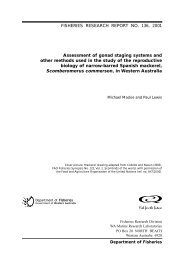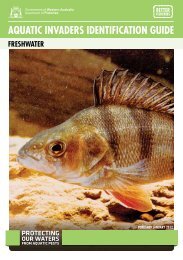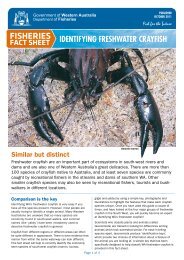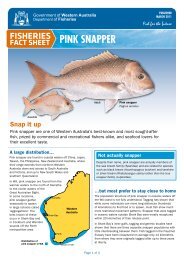West Australian Dhufish Fact Sheet - Department of Fisheries
West Australian Dhufish Fact Sheet - Department of Fisheries
West Australian Dhufish Fact Sheet - Department of Fisheries
Create successful ePaper yourself
Turn your PDF publications into a flip-book with our unique Google optimized e-Paper software.
Barotrauma<br />
You have probably heard <strong>of</strong> SCUBA divers getting ‘the<br />
bends’ because they ascended to the surface too quickly<br />
after a deep dive. Some demersal fish experience similar<br />
problems when they are caught in deep water and pulled<br />
rapidly to the surface on a fishing line. This condition,<br />
which results from gases expanding in the fish’s body, is<br />
called barotrauma.<br />
The most obvious signs <strong>of</strong> barotrauma in a fish are a<br />
bloated stomach, bulging eyes and the stomach pushed<br />
out through the mouth or gills. A fish with these symptoms<br />
may not survive when put back and may simply float on the<br />
sea surface. However, its chances <strong>of</strong> recovering may be<br />
improved if a fisher uses a release weight.<br />
A release weight consists <strong>of</strong> a barbless hook with a weight<br />
attached that is inserted through the fish’s lip. The fish is<br />
then lowered into the water and when it reaches the depth<br />
from which it came, it can be released by a gentle tug on<br />
the line. Once back in deep water, gases in the fish swiftly<br />
recompress, saving it from further injury.<br />
Page 2 <strong>of</strong> 4<br />
Predators and prey<br />
‘Dhuies’ have big eyes and cavernous mouths, with which<br />
they prey on other fish, crustaceans and molluscs such as<br />
squid and octopus. As larvae and juveniles they may be prey<br />
to a wide range <strong>of</strong> other sea creatures.<br />
Adult dhufish have a distinctive vertical dark line called a<br />
chevron running through their eye that fades once they die<br />
and which is also fainter on females. Juvenile dhuies have<br />
black stripes along their body.<br />
A three-month-old juvenile dhufish measuring just over three<br />
centimetres. Photo: Julia Shand, University <strong>of</strong> WA<br />
At the larval stage, dhufish have huge eyes relative to<br />
their head size. This makes them very well adapted to<br />
seeing in low levels <strong>of</strong> light.<br />
Summer spawning<br />
During spawning, eggs and sperm are released into the<br />
water and fertilisation occurs externally. At these times,<br />
dhufish may gather in groups called ‘aggregations’. This<br />
generally occurs between November and April with the peak<br />
period being between December and March, when water<br />
temperatures are elevated.<br />
While there is much about dhufish behaviour that is yet to<br />
be fully understood, it appears that this species displays<br />
complex social behaviour during spawning with larger<br />
individuals dominating and achieving greater spawning<br />
success. Males and females probably spawn in pairs.<br />
Gender difference<br />
Adult male dhufish are <strong>of</strong>ten bigger than female dhufish.<br />
Another easy way to tell the difference between male and<br />
female dhufish is the presence <strong>of</strong> an elongated filament on<br />
the dorsal fins <strong>of</strong> males.<br />
Filament<br />
Photo: Garry Lilley An adult male dhufish. Note the long filament on its dorsal fin.
















